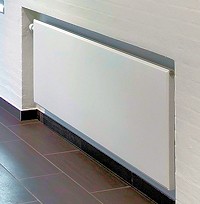If we put to one side designer radiators and towel warmers that come in all sorts of varying shapes and sizes, we are left with a few standard radiators. However generally the most common type of radiator, whether in a domestic or commercial setting, is the typical flat paneled one; white with a corrugated or flat front.
Within this style there are a number of variants – single panel radiators/double panel radiators/triple panel radiators and equal variations with convector fins. The panel is also known as a ‘tank’. When these tanks that are filled with water and the water is heated, they emit heat which in turn warms your room. The more surface area there is for the radiator, the greater the output. Therefore, a central heating radiator with a double panel of the same dimensions as a single panel radiator will give off more heat, as the total surface area is greater. (Heat output is measured in British Thermal Units – BTUs – or Watts)
Before we understood the basics of radiation and convection, you probably ended up with under performing radiators. It was then discovered that more surface area would increase heat output and so the multiple panel radiator was born. Since then radiator design has seen the introduction of a new radiator component called ‘convector fins.’
Convector fins are the folded metal strips that you may have seen at the back of panel radiators. The convector fins are connected to the panel or panels and are heated up by the water inside, thus increasing convection.
Within this framework, flat panel radiators can give a huge variety of sizes and outputs. Add to this the relative cost of production, storage and transportation; should it be a surprise that they are so ubiquitous?

